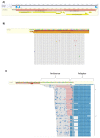An Omics Approach to Extracellular Vesicles from HIV-1 Infected Cells
- PMID: 31362387
- PMCID: PMC6724219
- DOI: 10.3390/cells8080787
An Omics Approach to Extracellular Vesicles from HIV-1 Infected Cells
Abstract
Human Immunodeficiency Virus-1 (HIV-1) is the causative agent of Acquired Immunodeficiency Syndrome (AIDS), infecting nearly 37 million people worldwide. Currently, there is no definitive cure, mainly due to HIV-1's ability to enact latency. Our previous work has shown that exosomes, a small extracellular vesicle, from uninfected cells can activate HIV-1 in latent cells, leading to increased mostly short and some long HIV-1 RNA transcripts. This is consistent with the notion that none of the FDA-approved antiretroviral drugs used today in the clinic are transcription inhibitors. Furthermore, these HIV-1 transcripts can be packaged into exosomes and released from the infected cell. Here, we examined the differences in protein and nucleic acid content between exosomes from uninfected and HIV-1-infected cells. We found increased cyclin-dependent kinases, among other kinases, in exosomes from infected T-cells while other kinases were present in exosomes from infected monocytes. Additionally, we found a series of short antisense HIV-1 RNA from the 3' LTR that appears heavily mutated in exosomes from HIV-1-infected cells along with the presence of cellular noncoding RNAs and cellular miRNAs. Both physical and functional validations were performed on some of the key findings. Collectively, our data indicate distinct differences in protein and RNA content between exosomes from uninfected and HIV-1-infected cells, which can lead to different functional outcomes in recipient cells.
Keywords: HIV-1; RNA sequencing; extracellular vesicle; proteomics.
Conflict of interest statement
None of the authors have conflicts of interest to disclose.
Figures








Similar articles
-
Effect of Kinases in Extracellular Vesicles from HIV-1-Infected Cells on Bystander Cells.Cells. 2025 Jan 15;14(2):119. doi: 10.3390/cells14020119. Cells. 2025. PMID: 39851547 Free PMC article.
-
Extracellular Vesicle Activation of Latent HIV-1 Is Driven by EV-Associated c-Src and Cellular SRC-1 via the PI3K/AKT/mTOR Pathway.Viruses. 2020 Jun 19;12(6):665. doi: 10.3390/v12060665. Viruses. 2020. PMID: 32575590 Free PMC article.
-
Antiretroviral Drugs Alter the Content of Extracellular Vesicles from HIV-1-Infected Cells.Sci Rep. 2018 May 16;8(1):7653. doi: 10.1038/s41598-018-25943-2. Sci Rep. 2018. PMID: 29769566 Free PMC article.
-
Exosomes: Implications in HIV-1 Pathogenesis.Viruses. 2015 Jul 20;7(7):4093-118. doi: 10.3390/v7072810. Viruses. 2015. PMID: 26205405 Free PMC article. Review.
-
Modulation of apoptosis and viral latency - an axis to be well understood for successful cure of human immunodeficiency virus.J Gen Virol. 2016 Apr;97(4):813-824. doi: 10.1099/jgv.0.000402. Epub 2016 Jan 13. J Gen Virol. 2016. PMID: 26764023 Review.
Cited by
-
Soluble Insulin Receptor Levels in Plasma, Exosomes, and Urine and Its Association With HIV-Associated Neurocognitive Disorders.Front Neurol. 2022 Jun 2;13:809956. doi: 10.3389/fneur.2022.809956. eCollection 2022. Front Neurol. 2022. PMID: 35720083 Free PMC article.
-
Long Non-coding RNAs Mechanisms of Action in HIV-1 Modulation and the Identification of Novel Therapeutic Targets.Noncoding RNA. 2020 Mar 13;6(1):12. doi: 10.3390/ncrna6010012. Noncoding RNA. 2020. PMID: 32183241 Free PMC article. Review.
-
Human Adenovirus Serotype 3 Infection Modulates the Biogenesis and Composition of Lung Cell-Derived Extracellular Vesicles.J Immunol Res. 2021 Dec 9;2021:2958394. doi: 10.1155/2021/2958394. eCollection 2021. J Immunol Res. 2021. PMID: 34926703 Free PMC article.
-
Harnessing crosstalk between extracellular vesicles and viruses for disease diagnostics and therapeutics.Extracell Vesicles Circ Nucl Acids. 2024 Jul 7;5(3):358-370. doi: 10.20517/evcna.2024.30. eCollection 2024. Extracell Vesicles Circ Nucl Acids. 2024. PMID: 39697627 Free PMC article. Review.
-
Important role of microglia in HIV-1 associated neurocognitive disorders and the molecular pathways implicated in its pathogenesis.Ann Med. 2021 Dec;53(1):43-69. doi: 10.1080/07853890.2020.1814962. Epub 2020 Sep 17. Ann Med. 2021. PMID: 32841065 Free PMC article. Review.
References
-
- WHO|World Health Organization. [(accessed on 26 April 2017)]; Available online: http://www.who.int/hiv/en/
-
- HIV in the United States|Statistics Overview|Statistics Center|HIV/AIDS|CDC. [(accessed on 26 April 2017)]; Available online: https://www.cdc.gov/hiv/statistics/overview/ataglance.html.
-
- U.S. Statistics|HIV.gov. [(accessed on 4 January 2019)]; Available online: https://www.hiv.gov/hiv-basics/overview/data-and-trends/statistics.
Publication types
MeSH terms
Grants and funding
LinkOut - more resources
Full Text Sources
Other Literature Sources
Medical
Molecular Biology Databases

